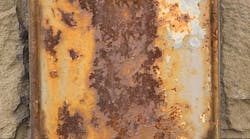A buried iron or steel plate used as a grounding electrode shall expose not less than _____ of surface area to exterior soil.
a) 1 sq ft
b) 2 sq ft
c) 4 sq ft
d) 6 sq ft
See answer and applicable Code reference
The correct answer is: b) 2 sq ft
Grounding electrode requirements are outlined in Sec. 250.52 of the 2011 NEC. As noted in 250. 52(A)(7), "Each plate electrode shall expose not less than 2 sq ft of surface to exterior soil. Electrodes of bare or conductively coated iron or steel plates shall be at least 1/4 in. in thickness. Solid, uncoated electrodes of nonferrous metal shall be at least 0.06 in. in thickness."
